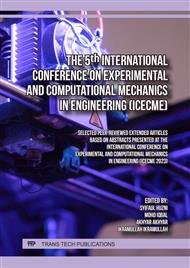[1]
Minami, I. 2017. Molecular Science of Lubricant Additives. Applied Sciences (Switzerland) 7 (5)
DOI: 10.3390/app7050445
Google Scholar
[2]
Gryglewicz, S., and B. Kolwzan. 2004. Synthesis and Biodegradation of Synthetic Oils Based on Adipic and Sebacic Esters. Journal of Synthetic Lubrication 20 (4): 281–88.
DOI: 10.1002/jsl.3000200402
Google Scholar
[3]
Hewstone, R. K. 1994. Environmental Health Aspects of Lubricant Additives. Science of the Total Environment, The 156 (3): 243–54.
DOI: 10.1016/0048-9697(94)90191-0
Google Scholar
[4]
J. R. Joshi, K. K. Bhanderi, and J. V. Patel, Waste cooking oil as a promising source for bio lubricants- A review. Journal of the Indian Chemical Society, vol. 100, no. 1. 2023.
DOI: 10.1016/j.jics.2022.100820
Google Scholar
[5]
D. Rahmadiawan et al., Tribological Properties of Aqueous Carboxymethyl Cellulose/Uncaria Gambir Extract as Novel Anti-Corrosion Water-Based Lubricant. Tribol. Ind., vol. 44, no. 4, 2022.
DOI: 10.24874/ti.1357.08.22.10
Google Scholar
[6]
N. Grishkewich, N. Mohammed, J. Tang, and K. C. Tam, Recent advances in the application of cellulose nanocrystals, Curr. Opin. Colloid Interface Sci., vol. 29, p.32–45, 2017.
DOI: 10.1016/j.cocis.2017.01.005
Google Scholar
[7]
L. A. Quinchia, M. A. Delgado, T. Reddyhoff, C. Gallegos, and H. A. Spikes, Tribological studies of potential vegetable oil-based lubricants containing environmentally friendly viscosity modifiers, Tribol. Int., vol. 69, p.110–117, 2014
DOI: 10.1016/j.triboint.2013.08.016
Google Scholar
[8]
R. K. Singh, O. P. Sharma, and A. K. Singh, Evaluation of cellulose laurate esters for application as green biolubricant additives, Ind. Eng. Chem. Res., vol. 53, no. 25, p.10276–10284, 2014.
DOI: 10.1021/ie501093j
Google Scholar
[9]
N. W. Awang, D. Ramasamy, K. Kadirgama, G. Najafi, and N. A. Che Sidik, Study on friction and wear of Cellulose Nanocrystal (CNC) nanoparticle as lubricating additive in engine oil, Int. J. Heat Mass Transf., vol. 131, p.1196–1204, 2019, doi: 10.1016/j.ijheatmasstransfer. 2018.11.128.
DOI: 10.1016/j.ijheatmasstransfer.2018.11.128
Google Scholar
[10]
Y. Zhang et al., Tribological properties of nano cellulose fatty acid esters as ecofriendly and effective lubricant additives, Cellulose, vol. 25, no. 5, 2018.
DOI: 10.1007/s10570-018-1780-9
Google Scholar
[11]
N. W. Awang, D. Ramasamy, K. Kadirgama, M. Samykano, G. Najafi, and N. A. C. Sidik, An experimental study on characterization and properties of nano lubricant containing Cellulose Nanocrystal (CNC), Int. J. Heat Mass Transf., vol. 130, 2019, doi: 10.1016/j.ijheatmasstransfer. 2018.11.041.
DOI: 10.1016/j.ijheatmasstransfer.2018.11.041
Google Scholar
[12]
D. Rahmadiawan, H. Abral, N. Nasruddin, and Z. Fuadi, Stability, Viscosity, and Tribology Properties of Polyol Ester Oil-Based Biolubricant Filled with TEMPO-Oxidized Bacterial Cellulose Nanofiber, Int. J. Polym. Sci., vol. 2021, p.5536047, 2021.
DOI: 10.1155/2021/5536047
Google Scholar
[13]
S. C. Shi and S. Z. Jiang, Influence of graphene/copper hybrid nanoparticle additives on tribological properties of solid cellulose lubricants, Surf. Coatings Technol., vol. 389, May 2020.
DOI: 10.1016/j.surfcoat.2020.125655
Google Scholar
[14]
Z. Fuadi et al., Effect of Graphene Nanoplatelets on Tribological Properties of Bacterial Cellulose/ Polyolester Oil Bio-Lubricant, Front. Mech. Eng., vol. 8, no. March, p.1–11, 2022.
DOI: 10.3389/fmech.2022.810847
Google Scholar
[15]
S. M. Hisham, K. Kadirgama, D. Ramasamy, and S. Rahman, Enhancement of Tribological Behaviour and Thermal Properties of Hybrid Nanocellulose/Copper (II) Oxide Nanolubricant, J. Adv. Res. Fluid Mech. Therm. Sci., vol. 72, no. 1, 2020.
DOI: 10.37934/arfmts.72.1.4754
Google Scholar
[16]
S. Hisham et al., Hybrid nanocellulose-copper (II) oxide as engine oil additives for tribological behavior improvement, Molecules, vol. 25, no. 13, 2020.
DOI: 10.3390/molecules25132975
Google Scholar
[17]
S. D. Fernández-Silva, M. A. Delgado, C. Roman, and M. García-Morales, Rheological and tribological properties of nanocellulose-based ecolubricants, Nanomaterials, vol. 11, no. 11, 2021.
DOI: 10.3390/nano11112987
Google Scholar
[18]
P. G. L. Da Rocha et al., Tribological performances of cellulose nanocrystals in water-based lubricating fluid, J. Appl. Polym. Sci., vol. 139, no. 20, 2022.
DOI: 10.1002/app.52167
Google Scholar
[19]
M. J. Shariatzadeh and D. Grecov, Aqueous suspensions of cellulose nanocrystals as water-based lubricants, Cellulose, vol. 26, no. 7, 2019.
DOI: 10.1007/s10570-019-02398-w
Google Scholar
[20]
J. Li et al., Tribological behavior of cellulose nanocrystal as an eco-friendly additive in lithiumbased greases, Carbohydr. Polym., vol. 290, 2022.
DOI: 10.1016/j.carbpol.2022.119478
Google Scholar



